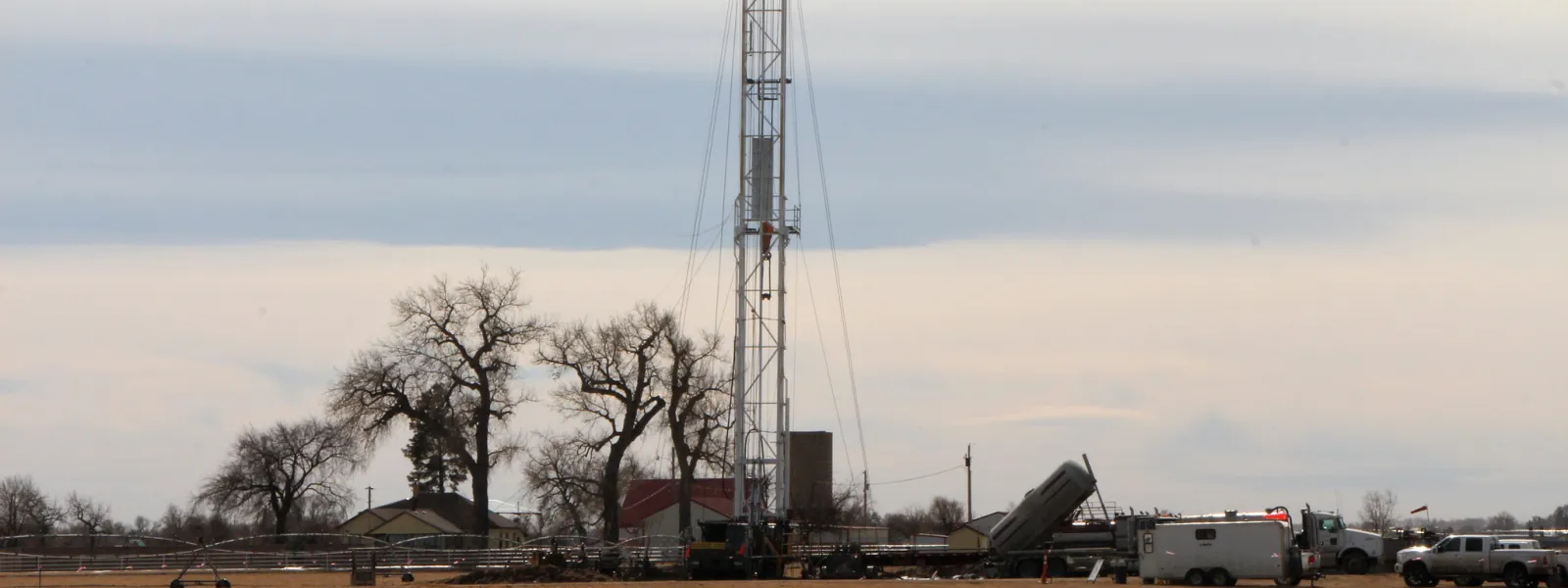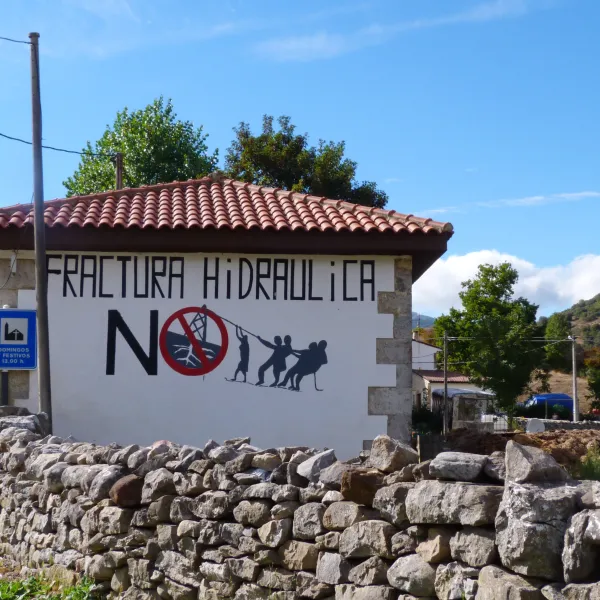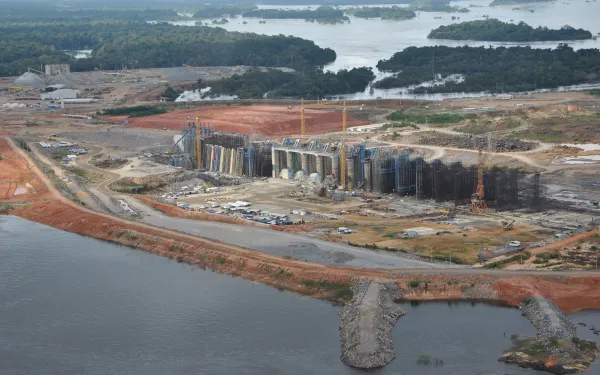
Project
Foto: Andrés ÁngelStopping the spread of fracking in Latin America
“Fracking” is short for hydraulic fracturing, a process used to extract oil and natural gas from historically inaccessible reservoirs.
Fracking is already widespread in the global North, but in Latin America, it is just beginning. Governments are opening their doors to fracking without understanding its impacts and risks, and without consulting affected communities. Many communities are organizing to prevent or stop the impacts of fracking, which affect their fundamental human rights. But in many cases they require legal and technical support.
What exactly is fracking, and what are its impacts?
A straight hole is drilled deep into the earth. Then the drill curves and bores horizontally, making an L-shaped hole. Fracking fluid—a mixture of water, chemicals, and sand—is pumped into the hole at high pressure, fracturing layers of shale rock above and below the hole. Gas or oil trapped in the rock rises to the surface along with the fracking fluid.
The chemical soup—now also contaminated with heavy metals and even radioactive elements from underground—is frequently dumped into unlined ponds. It may seep into aquifers and overflow into streams, poisoning water sources for people, agriculture, and livestock. Gas may also seep from fractured rock or from the well into aquifers; as a result, water flowing from household taps can be lit on fire. Other documented harms include exhausted freshwater supplies (for all that fracking fluid), air pollution from drill and pump rigs, large methane emissions that aggravate global warming, earthquakes, and health harms including cancer and birth defects.
AIDA’s report on fracking (available in Spanish) analyzes the viability of applying the precautionary principle as an institutional tool to prevent, avoid or stop hydraulic fracturing operations in Latin America.
Partners:

Related projects
Costa Rica's High Court Annuls Industrias Infinito's Crucitas Mining Project Concession
25th November, 2010, San José, Costa Rica – The Costa Rican Administrative Court set a historical precedent in the region yesterday when it annulled the concession granted to Industrias Infinito for the development of the Crucitas Gold Mining Project in Curtis, San Carlos. The Court annulled the concession because it violates environmental regulations, and because of the environmental damage caused by the project. “We welcome the Court’s decision because it regulates a project that attempted to go against national and international norms,” said Gladys Martínez J.D., lawyer for the Interamerican Association for Environmental Defense (AIDA). “We congratulate each and every one of the national environmental organizations that participated in this judicial process, and especially our partner organization the Centre for Environmental Law and Natural Resources (CEDARENA), for their undying efforts in defense of the environment” added Martínez. “We hope that Costa Rica’s example is followed by other nations,” said Astrid Puentes R., Co-Director of AIDA. “Open-pit mines can cause irreparable environmental damage and human rights violations, so compliance with norms and regulations is of the upmost importance,” added Puentes. In August 2008, AIDA sent to then-President of Costa Rica Oscar Arias a document that warned about the international regulations that the Crucitas Project would violate, given the possible impacts on Nicaraguan territory and the San Juan River. AIDA’s efforts and arguments are in line with the recent Court decision, which reiterates the importance of complying with such regulations. In fact, the Court recommended the criminal investigation of the ex-President Arias for having authorized the project, regardless of norms, through an executive decree. AIDA is a nongovernmental international environmental law organization that has fought for the prevention of negative environmental impacts from the open-pit-mining industry in South America. As part of its mission to protect people’s right to a healthy environment, AIDA works alongside partner organizations on the continent, as well as with other organizations and communities. To find out more about our efforts to prevent harmful mining projects, visit http://www.aida-americas.org/en/freshwater
Read moreIndigenous and Riverbank Communities Call on the Inter-American Commission on Human Rights to Suspend the Massive Belo Monte Dam in the Brazilian Amazon
FOR IMMEDIATE RELEASE November 11, 2010 Media Contacts: Astrid Puentes, AIDA - +1 510 984 4610, [email protected] Andressa Caldas, Justiça Global: +55 21 2544 2320 / 21 8187 0794, [email protected] Renata Pinheiro, Xingu Alive Forever Movement: + 55 93 9172 9776, [email protected] Christian Poirier, Amazon Watch: +1 510-666-7565, [email protected] As the government prepares to issue the dam’s construction license, communities urge the Commission to denounce illegalities in licensing and violations of human rights Washington, D.C., Brazil- Today international and Brazilian human rights and environmental organizations submitted a formal petition to the Inter-American Commission on Human Rights (IACHR), denouncing grave and imminent violations upon the rights of indigenous and riverine communities that will be affected by the construction of Belo Monte Dam Complex on the Xingu River in the Brazilian Amazon. Signed by the Xingu Alive Forever Movement as well as the representatives of affected communities – the Conselho Indigenista Missionário (CIMI), Coordenação das Organizações Indígenas da Amazônia Brasileira (COIAB), Prelazia do Xingu, Sociedade Paraense de Direitos Humanos (SDDH), Justiça Global, and the Interamerican Association for Environmental Defense (AIDA) – with the support of over twenty organizations and social movements, the petition urgently calls on the Commission to adopt “precautionary measures” that would compel the Brazilian government to halt plans to build the dam, slated to be world’s 3rd largest. The petition documents the Brazilian government’s violation of international treaties, ignoring the fundamental rights of indigenous peoples from the lower Xingu Basin, including the Arroz Cru, Arara da Volta Grande, Juruna do Km 17 and Ramal pas Penas communities. It also highlights major threats posed by the Belo Monte Dam, including forced displacement of communities without insuring their free, prior and informed consent, threats to food security and access to drinking water. “The government claims that the Juruna will not be affected, but we do not believe this. We have not been consulted and we do not want the government to speak for us,” said Sheyla Juruna, member of a Juruna indigenous community that will be affected by Belo Monte. “We are against the Belo Monte Dam and we are committed to fight with our bodies and souls to defend our lives and the life of our river.” The IACHR petition comes on the same week as prosecutors from Brazil’s Federal Public Ministry (MPF) sent a document to Brazil’s environmental agency IBAMA advising that the agency not issue an installation license until the dam-building consortium Norte Energia can comply with an obligatory set of social and environmental conditions. Norte Energia and the Brazilian government have been pushing IBAMA to issue a “partial” installation license, which would allow the project to break ground without complying with legally binding conditions on the dam’s provisional license. Based on assessments from government agencies – like IBAMA [Brazil’s environmental agency] and the Federal Public Ministry – and those from groups of specialists, the organizations affirm that the construction of Belo Monte will increase illness and poverty, while causing a surge of disorderly migration to the region that will overload health, education, and public safety infrastructure. The petition concludes: "Despite the gravity and irreversibility of the impacts of the project to local communities, there were no appropriate measures taken to ensure the protection of human rights and the environment." “It worries us how the Brazilian government is ignoring national and international standards to accelerate this project, even at the expense of human rights and the environment,” affirmed Astrid Puentes Riaño, the co-Director of the Interamerican Association for Environmental Defense (AIDA). “Moving forward without taking precautions required by international norms will only result in human rights violations and the irreversible destruction of a critically important region of the Amazon.” In addition to calling attention to the illegalities and human rights violations associated with the Belo Monte Dam, the petition cites an important precedent, pointing out that in 2009 the IACHR implemented similar precautionary measures, leading to the suspension of the Chan-75 hydroelectric dam in Panama due to possible violations of indigenous communities’ rights. ### For more information on the Belo Monte Dam, visit: http://xingu-vivo.blogspot.com http://www.aida-americas.org http://www.internationalrivers.org http://amazonwatch.org /
Read more
Large dams in the Americas: Is the cure worse than the disease?
Large dams consistently cause severe, and often irreversible, environmental and social damage. Their construction is also often associated with violations of international human rights and environmental laws. AIDA’s report Large Dams in the Americas: Is the Cure Worse than the Disease? explores these grave impacts and explains the existing international standards that should be applied to protect the environment and human rights. The report also exposes the dangers of using large hydroelectric dams to meet increasing energy demands in Latin America. To promote greater protection of human rights, AIDA gave testimony based on this dams report to the Inter-American Commission on Human Rights (IACHR) at a general hearing on November 2, 2009. AIDA has also shared the report’s findings with international experts, policymakers, non-governmental organizations, affected local communities, and international financial institutions such as the World Bank and the Inter-American Development Bank. Furthermore, AIDA staff presented legal strategy workshops at "Rivers for Life 3", an international meeting of dam-affected communities in Temacapulín, Mexico, October 1-7, 2010. The previous month, AIDA staff represented Latin America on a panel of water experts at World Water Week in Stockholm. In Large Dams in the Americas, AIDA examines five large hydroelectric dams in violation of a range of environmental and human rights laws: Yacyretá in Argentina and Paraguay, Río Madeira in Bolivia and Brazil, Baba in Ecuador, Chan-75 in Panama, and La Parota in Mexico. Through these case studies, AIDA illustrates how governments generally disregard important international obligations and standards, such as the need to conduct proper environmental and social impact assessments. In the report, we also explain the significant social and environmental impacts caused by large dams. We discuss how families suffer when they are displaced or forcefully evicted by dams and lose valuable farmland, water sources, or traditional fishing areas. We document how the people most harmed by large dams are those from vulnerable populations, including indigenous, afro-descendent and poor farming communities. We also describe how large dams typically harm the environment by flooding valuable ecosystems, dramatically altering natural flows of water, disrupting wildlife habitat, and obstructing the migratory paths of perse species, among other impacts. In addition, Large Dams in the Americas dispels the myth that dams are a source of "green energy". Even though dams do not rely on fossil fuels to generate electricity, they still contribute to greenhouse gas emissions. Hydroelectric dams create enormous reservoirs of river water that submerge valleys and lead to the decomposition of vast amounts of organic matter. As the trees and other biomasses break down, they release carbon dioxide and methane, the same greenhouse gases that are created by "dirty" technologies like coal-fired electricity plants. Turbines also liberate methane trapped in deep water and emit carbon dioxide as they release pressure from the reservoir. In tropical regions, dams can emit as much as eleven times the amount of greenhouse gases that a conventional power plant of equivalent size would emit. Given the negative impacts of large dams, AIDA's report recommends that policymakers seriously consider alternatives that protect human rights and our natural ecosystems, save energy, and reduce greenhouse gas emissions. Suggested alternatives include: improving energy efficiency, reducing demand, making better use of sustainable energy sources, investing in energy-efficient technologies and infrastructure, and removing barriers that hinder technology exchange between nations. AIDA wrote this report in collaboration with our participating organizations, CEMDA, CEDHA, ECOLEX and Earthjustice, as well as International Rivers, Sobrevivencia, and the Association for Conservation and Development (ACD). By educating governments, policymakers, communities, and other key players about large dams, we seek to encourage authorities to investigate the matter and apply our recommendations on how to implement dam projects in compliance with international laws. Spanish-Language Report Available Here
Read more